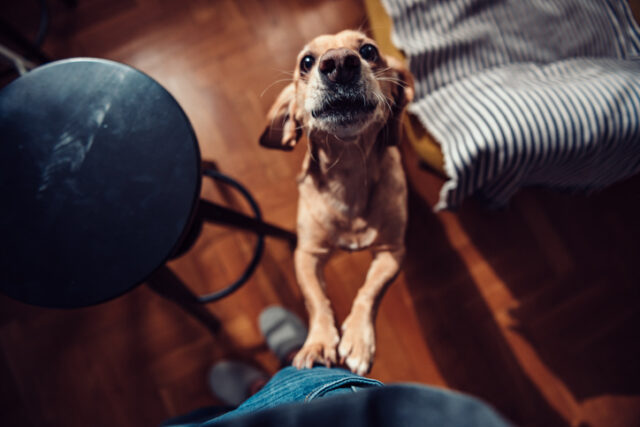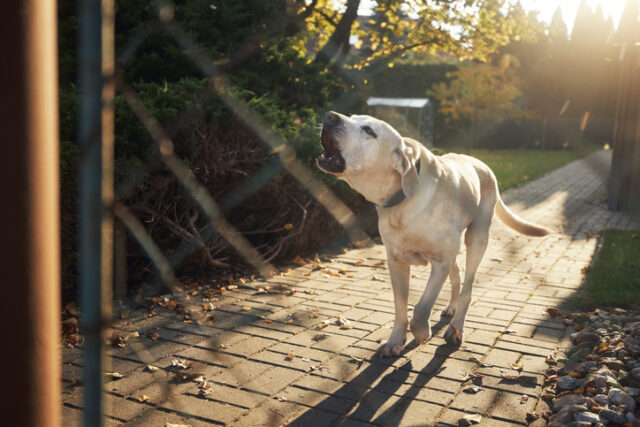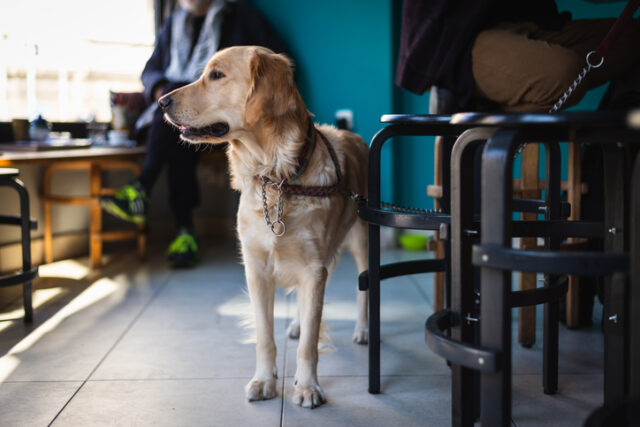We all want our dogs to be happy, but just like humans, pups can struggle emotionally too.

The reasons for this are varied and will depend on your pet’s and your home’s unique circumstances. However, regardless of cause, it’s important to get to the bottom of the problem so you can address it and help them feel better. If you’re wondering whether your dog might be feeling low, here are 13 signs you shouldn’t ignore.
1. They’re sleeping way more than usual.

Sure, dogs love a good nap—it’s basically a core part of their brand. But if your normally energetic dog is suddenly spending most of the day curled up and snoozing, it could be a sign something’s wrong. Excessive sleepiness often points to a lack of stimulation, sadness, or even deeper emotional distress.
It’s important to look at the bigger picture. If the sleepiness comes with other changes, like ignoring toys or seeming less responsive, it’s time to check in. Dogs can’t tell you they’re feeling down with words, but their body language and energy levels speak volumes.
2. Their eating habits have changed.

When a dog’s appetite shifts, it’s usually a big flashing signal. If your pup normally rushes to their food bowl but now barely sniffs it, something deeper could be going on emotionally. A loss of appetite is a common indicator of depression, especially when paired with low energy and withdrawal.
On the flip side, some dogs will overeat when they’re feeling anxious or unsettled, much like humans do. If you notice sudden weight loss, weight gain, or unusual eating patterns, it’s not just a phase — it’s their way of showing something’s out of balance internally.
3. They’re hiding or isolating themselves.

Social dogs who suddenly prefer to hide under beds, behind couches, or in other tucked-away spots are quietly telling you something’s wrong. Isolation is often a way dogs try to self-soothe when they’re feeling overwhelmed or emotionally drained.
It’s heartbreaking, especially if your pup normally loves being in the middle of the action. If they’re deliberately withdrawing from the family, it’s time to create a soft, safe space for them and gently encourage them to reconnect, without forcing it.
4. They’ve lost interest in their favourite things.

A dog’s pure joy over a ball, a squeaky toy, or even just hearing the word “walk” is one of the best parts of having a pup. So when that excitement fades, it’s a major warning sign. Loss of interest in favourite activities usually signals emotional fatigue or depression.
If your dog isn’t even perking up at the rustle of a leash or the offer of a treat, it’s not something to brush off. Their disinterest is their quiet way of saying, “I don’t feel like myself,” and it deserves serious attention and care.
5. They’re extra clingy, or completely withdrawn.

Some depressed dogs become little shadows, following their owners from room to room, needing constant reassurance. Others do the complete opposite and pull away from even basic affection. Extreme shifts in how much affection they want are clear signs their emotional world is unsettled.
It’s important to watch for either side of the clingy-or-cold spectrum. Whichever way your dog swings, they’re trying to communicate that they’re not okay. Meeting them with patience, extra cuddles if they want them, and professional help if needed, can make all the difference.
6. They’re more vocal than usual.

Dogs often “talk” through barking, whining, or howling, but when those sounds ramp up without any clear reason, it’s time to dig deeper. Constant vocalising might be their way of releasing stress, confusion, or loneliness they don’t know how else to express.
Sometimes the vocal changes are subtle, like a soft whine when you leave the room, or random barking at nothing in particular. However, if you notice a pattern where your dog seems louder and less settled than usual, it’s a red flag worth addressing before the anxiety escalates.
7. Their body language looks different.

Dogs are masters of non-verbal communication. When they’re emotionally struggling, their whole posture changes—tails tucked, heads lowered, ears back, even slight trembling. These small but powerful cues often say more than any bark or whimper ever could.
Learning your dog’s typical “happy” body language makes it easier to spot when things go off course. If their usual waggy-tailed, alert posture turns into something low and droopy, that shift deserves your full attention and empathy.
8. They’re avoiding other dogs or people.

Dogs are naturally social, and even the more introverted ones usually have a few humans or dogs they enjoy being around. If your dog suddenly starts avoiding playdates, family members, or even their best four-legged buddies, it’s often rooted in emotional withdrawal.
Social disinterest isn’t just about moodiness; it’s often a sign that your dog feels vulnerable or overwhelmed. Gently supporting them without pushing too hard can help them feel safe enough to start re-engaging at their own pace.
9. They’re becoming destructive.

Chewing shoes, tearing up furniture, raiding the rubbish bin—destructive behaviour might seem like naughtiness, but it’s often your dog trying to self-soothe or cope with emotional distress. It’s a classic cry for help disguised as chaos. Instead of scolding, take a step back and ask: what’s missing from their life right now? Destructive actions are usually symptoms of boredom, frustration, sadness, or anxiety that’s been building up silently for a while.
10. They’ve become more sensitive or jumpy.

Dogs going through emotional struggles often develop heightened startle responses. Normal household noises, new visitors, or small disruptions might make them jump, cower, or bark nervously, even if they were confident before. It’s a heartbreaking shift, and it shows their nervous system is on edge. Offering extra reassurance, consistent routines, and safe spaces can help your jumpy dog start rebuilding trust in their surroundings.
11. They seem restless and can’t settle.

If your dog is pacing from room to room, circling the same spot, or lying down only to pop back up again seconds later, it’s a big clue that something inside isn’t sitting right. True restlessness is often an outward sign of internal turmoil. It’s tough to watch, but try to respond with patience rather than frustration. Helping them find calm — whether through gentle play, massage, or professional support — can slowly ease the agitation they’re feeling deep down.
12. They’ve suddenly developed new fears.

New fears — whether it’s thunder, loud noises, strangers, or even a squeaky toy — can emerge suddenly when dogs are feeling emotionally fragile. Depression and anxiety make everyday life feel scarier and less predictable for them. If your dog’s started shrinking back from normal things, it’s not them “acting up.” It’s a cry for help from a place of vulnerability. Building back their confidence slowly and lovingly is the key to helping them feel safe again.
13. You just know something’s off.

Sometimes you can’t list a bunch of symptoms — you just know in your gut that your dog isn’t themselves. Their energy feels off, their eyes look different, or their usual joy seems muted. Trust that instinct. No one knows your dog better than you. Acting early, even if it’s just checking in with the vet or adjusting their routine, can make all the difference in catching emotional struggles before they deepen.




